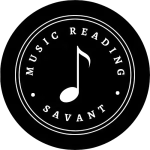| This reading music lesson is a supplement to the Alfred’s Essentials of Music Theory self-study workbook. While no book is perfect for learning how to read music, this is one of the best available. The concise explanations, brief practice exercises, ear-training CD’s, glossary of music terms, and answer key make it an excellent value. Buy this top-rated self-study course for beginners to advanced musicians and follow along with me. |
What is Pitch?
The musical sounds that you hear when a music note is played are called pitch.
Pitch is relative. When we compare the pitch of one note to another note, we can hear if it is higher or lower in sound.
The location of the note on the staff determines how high or low it will be in pitch when you read it.
The higher the note is written on the music staff, the higher the pitch will sound.

The lower the note you find on the staff, the lower it will sound.

If you look at this example once again, we can say that:

- The note in space 1 is lower than the note in space 3. Therefore, it will sound lower in pitch.
- The space 4 note is higher than the space 2 note and will sound higher in pitch.
Now, let’s do the same thing with this example.

- The note on line 1 is lower than the note in line 3. Therefore, it will sound lower in pitch.
- The note on line 5 is higher than the note in line 2 and will sound higher in pitch.

Very helpfull